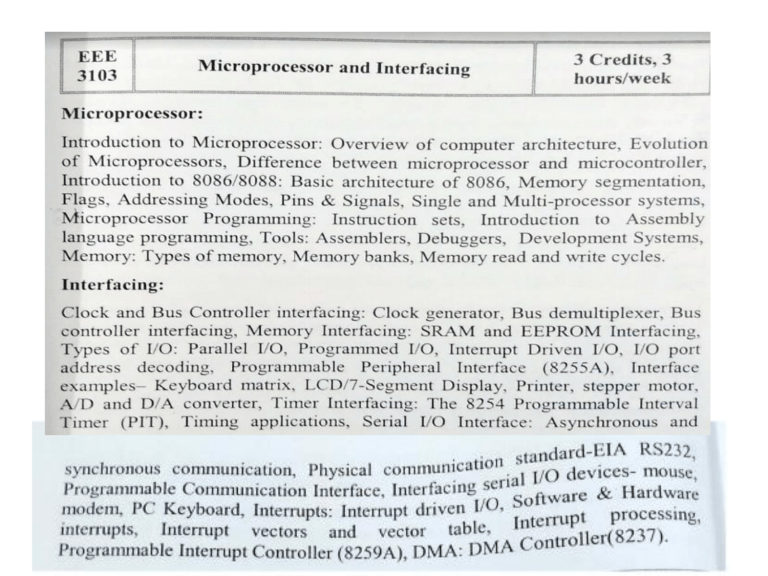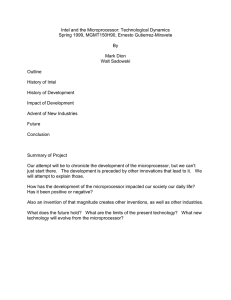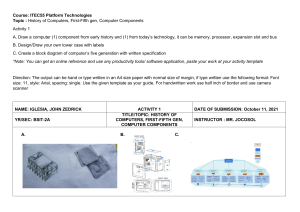
What is a Microprocessor: A Microprocessor is a multipurpose, programmable, clock-driven, register-based electronic device that reads binary instructions from a storage device called memory; accepts binary data as input and processes data according to those instructions, and provides results as output. CPU: A central processing unit (CPU) is the electronic circuitry within a computer that carries out the instructions of a computer program by performing the basic arithmetic, logical, control and input/output (I/O) operations specified by the instructions. In case of PC (personal computer), the term "CPU" refers to a microprocessor. •Some features of microprocessor: The microprocessor uses the same type of logic that is used in a digital computer's central processing unit (CPU). •Because of its resemblance to the CPU, and because it is constructed with microcircuit (integrated circuit) technology, we say it is a microprocessor. •Like the CPU, the microprocessor has digital circuits for data handling and computation under program control. In other words, the microprocessor is a data processing unit. •Data processing is the microprocessor's main function. Data processing includes both computation and data movement. Computation is performed by logic circuits that make up what is usually called the Arithmetic and Logic Unit (ALU). •These logic circuits enable us to use functions that cause data changes. Among these functions are Add, Subtract, AND, OR, Compare, Increment, and Decrement •The ALU cannot itself move data from place to place. Instead, the ALU merely performs an operation on whatever data it finds in certain places, and it leaves the result in the same place. •The ALU cannot itself move data from place to place. Instead, the ALU merely performs an operation on whatever data it finds in certain places, and it leaves the result in the same place. •The microprocessor has other logic circuits, outside the ALU, that handle data. This data-handling logic moves data into places so that the ALU can process the data. After the operation, the data-handling logic moves the data elsewhere. What tells the ALU how to process the data? In order to process data, the microprocessor must have control logic which tells the microprocessor how to decode and execute the program—a set of instructions for processing the data. The control logic steps the microprocessor through the stored program steps (instructions) in memory. It calls (fetches) them one at a time. After the instruction is fetched, the microprocessor's control logic decodes the instruction. Then the control logic carries out (executes) the decoded instruction. The instructions that you store in memory determine what the microprocessor will do. To review: The microprocessor's purpose is to process data. The microprocessor operates in the following steps. First, the microprocessor fetches (gets) an instruction. Then the control logic decodes what the instruction says to do. After decoding, the microprocessor executes (carries out) the instruction. These steps are called the fetch-andexecute cycle, or the fetch/ execute cycle. For each instruction in memory, the microprocessor goes through one fetch-and-execute cycle. The control logic controls how the microprocessor works with all of the outside circuits (memory, input, and output) connected to the microprocessor. Powerful though the microprocessor is, it can do nothing by itself. The microprocessor must have the aid of other circuits. Some memory circuits are required to store the program instructions. Circuits are also needed to move data into and out of the microprocessor; these circuits are called input/output (I/O) circuits. Storage of data requires additional memory. The microprocessor also needs a power supply. What is a microcomputer: The microcomputer is a complete computing system built around a microprocessor. A complete computing system has a microprocessor-based CPU, and it has memory and input/ output function. Power of a microprocessor: What we mean by the power of a microprocessor is its capacity to process data. There are three main measures of the power of a microprocessor: 1) the length of the microprocessor's data word; 2) the number of memory words that the microprocessor can address; and 3) the speed with which the microprocessor can execute an instruction. Evolution of Microprocessor (Book-Barray) : The history of microprocessor evolved since 1971 when Intel developed the world’s first microprocessor 4004. It was a four bit microprocessor. The other successive processors are shown in table 1.1. Pentium D processor in 2005 Pentium dual core 2007 Pentium core 2 duo 2008 And now the latest microprocessor is Core i7 Photograph of the Intel’s first microprocessor 8008 8088 80186 8086 80486 Types of Microprocessor: In response to the expressed needs, microprocessors have evolved in three major directions during the last 30 years. DEDICATED CONTROLLERS Dedicated controllers are small microprocessors used to control "smart" machines such as microwave ovens, washing machines, sewing machines, auto ignition systems, metal lathes and many other control systems . They are also called microcontroller. In fact a microcontroller itself is a complete computer with limited capacity. They also contain application specific units such as ADC, Timer, PWM generator, Clock generator etc.. Texas Instruments produced millions of their TMS-1000 family of 4-bit microprocessors for this type of application. ln 1976 Intel introduced the 8048, which contains an 8-bit CPU. RAM, ROM, and some I/O ports all in one 40-pin package. Other manufacturers have followed with similar products. Some currently available devices in this category are the PIC and Atmega series. BIT-SLICE PROCESSORS The second category of microprocessors is the bit-slice processors. For some applications general-purpose CPUs are not fast enough or their instruction sets are not suitable. For these applications several manufacturers produce devices which can be used to build a custom CPU. An example is the Advanced Micro Devices AMD-2900 family of devices. This family includes 4bit ALUs, multiplexers, sequencers, and other parts needed for custombuilding a CPU. Intel’s bit slice family is 3000. The term slice comes from the fact that every processor constitutes a slice of the whole word capacity of the computer. These parts can be connected in parallel to work with 8-bit words, 16-bit words, or 32-bit or even more bit words. A designer can add as many slices as needed for a particular application. The designer not only custom-designs the hardware of the CPU, but also custom-makes the Instruction set for it using "microcode." GENERAL-PURPOSE CPUs The third category of microprocessors is the general-purpose CPUs which are used in small computers (eg. PC, Laptop) and does all the computational work of small computers. All of the microprocessor we use in computers are general purpose microprocessors. Extra Segment Code Segment Stack Segment Data Segment Instruction pointer Accumulator 8+8 Base 8+8 Counter 8+8 Data 8+8 Stack Pointer 16 Base pointer Source Index Destination Index Register Accumulator Register/ AX/ AH-AL Base register/ BX/ BH-BL Data register Special Purpose register Counter register/ CX/ CH-CL Data register/ DX/ DH-DL Segment register Code Segment/ CS Data Segment/ DS Stack Segment/ SS Extra Segment/ ES Address Register Pointer register Instruction Pointer/ IP Base Pointer/ BP Stack Pointer/ SP Index register Source Index/ SI Destination Index/ DI Status Register Flag register 6 status flag and 3 control flag



